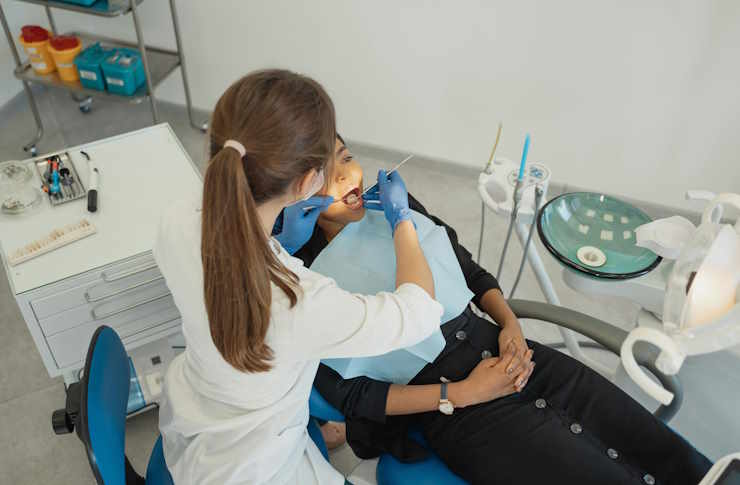Understanding plaque biofilm and its role in periodontal progression
Plaque biofilm is a structured community of microbes on tooth surfaces that can trigger local inflammation and tissue changes. Understanding how plaque develops, how the oral microbiome shifts, and which clinical steps interrupt progression helps explain why consistent hygiene and professional care are central to preventing gingivitis from advancing to periodontitis.

Plaque is more than a soft film on teeth; it is a living, organized biofilm that interacts with the host immune system and surrounding tissues. Over time, if not regularly removed, plaque biofilm can cause persistent inflammation. That inflammation may present early as gingivitis and, without intervention, can advance into deeper periodontal damage. Clinicians use a combination of mechanical removal and targeted antiseptics to reduce microbial load, while patients are advised to maintain daily hygiene and regular professional maintenance visits.
This article is for informational purposes only and should not be considered medical advice. Please consult a qualified healthcare professional for personalized guidance and treatment.
What is plaque and how does it form?
Plaque begins when salivary proteins condition the tooth surface and free-floating bacteria attach. Over hours to days, additional species colonize and secrete extracellular polymeric substances that glue cells together into a matrix. The plaque community both shelters microbes and concentrates their metabolic byproducts. These processes help explain why simple brushing reduces bulk plaque but incomplete removal allows biofilm niches to persist, contributing to ongoing local inflammation if hygiene lapses.
What is a biofilm and why does it persist?
A biofilm is an organized microbial community embedded in a self-produced matrix. This structure confers resistance to mechanical removal and can reduce the effectiveness of topical antiseptics, because diffusion is limited and some bacteria enter a less active state. Biofilms also facilitate microbial interactions that shift the community profile. Once established along the gingival margin or within pockets, biofilm persistence becomes a key driver of chronic periodontal inflammation and tissue breakdown.
How does gingivitis progress to periodontitis?
Gingivitis describes reversible inflammation confined to the gums, often signaled by redness and bleeding on probing. If biofilm persists and the host response becomes dysregulated, inflammation can extend into the connective tissues and bone that support teeth. This deeper involvement characterizes periodontitis, marked by clinical signs such as pocket formation, attachment loss, and potentially recession. The transition depends on factors including biofilm composition, host susceptibility, systemic health, and local hygiene behaviors.
What role does the oral microbiome play?
The oral microbiome is the community of microbes in the mouth; its balance influences health and disease. In healthy sites, commensal species help resist colonization by more pathogenic organisms. Dysbiosis — a shift toward proteolytic, anaerobic species — is commonly observed in active periodontal sites. Managing the microbiome focuses on reducing pathogenic burden through mechanical removal, selective antiseptics, and promoting conditions that favor beneficial species, while recognizing that complete sterilization is neither feasible nor desirable.
Clinical treatments: scaling, rootplaning, and antiseptics
Mechanical therapies such as scaling and rootplaning remain foundational in disrupting subgingival biofilm and removing calculus that harbors microbes. Scaling removes supragingival and subgingival deposits; rootplaning smooths root surfaces to reduce future plaque adherence. Adjunctive use of antiseptics or locally delivered antimicrobials can reduce microbial counts temporarily, but their effectiveness depends on access, biofilm state, and patient factors. Treatment plans should be individualized and combined with behavioral measures to control re‑accumulation.
Hygiene, maintenance, regeneration, and recession outcomes
Effective daily hygiene and regular professional maintenance are complementary: home cleaning controls plaque growth between visits, while maintenance visits manage areas patients cannot access. When periodontitis has caused attachment loss, techniques aimed at regeneration can sometimes restore tissue, but outcomes vary with defect type and patient factors. Recession — apical migration of the gingival margin — may follow inflammation or mechanical therapy; careful technique and ongoing maintenance can limit further recession while optimizing long‑term tissue stability.
Conclusion Plaque biofilm is a dynamic, structured community that plays a central role in the transition from gingivitis to periodontitis. Preventing progression relies on interrupting biofilm formation through consistent hygiene, timely mechanical therapy such as scaling and rootplaning, appropriate use of antiseptics, and scheduled maintenance to preserve a favorable oral microbiome and minimize tissue recession. Clinical decisions are individualized and informed by both microbial factors and patient risk profiles.






